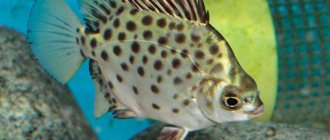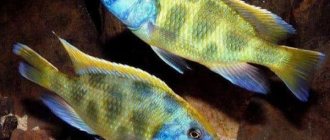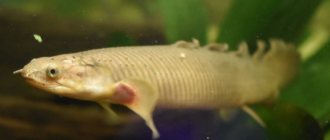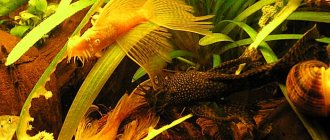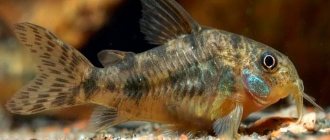It often happens that an experienced aquarist, who has been breeding various underwater inhabitants for many years, suddenly feels the need to acquire a completely new, hitherto unknown creature to replenish his collection and expand his own knowledge.
It also happens that a person who has never had an aquarium decides to install one, but he does not accept banalities and wants to place someone completely extraordinary in it. Such wishes can be satisfied by purchasing and breeding amazing creatures of nature called mudskippers.
General information
Mudskippers (Periophthalmus sp.) are a genus of tropical fish in the family Oxudercidae. Includes about 35 species. They are close relatives of gobies, so they closely resemble them in appearance. These fish live in the intertidal zone, which determined the appearance of a number of adaptations for their survival in such a changeable environment.
Jumpers spend most of their time digging in the mud
This fish has a number of unique features in its external and internal structure; to some extent it can be called a transitional form between fish and amphibians.
Appearance Features
The mudskipper looks quite unusual. Appearance:
- Size . The average size of an adult is about 25 cm.
- The body is oblong, of unusual shape, similar to a cone. The body is covered with a mucous membrane that performs a protective function. The tail, although short, is distinguished by its tenacity and muscularity.
- The head is quite large. It is so large that it largely exceeds the size of the body. At the same time, large bulging eyes and a large square-shaped mouth cavity give this fish a frightening and intimidating appearance.
- Fins . There is an elongated rectangular single dorsal fin, the color of which depends on the habitat conditions. The mudskip's pelvic fins have evolved to be used for traversing land rather than swimming.
- Color. The skin on the back is colored olive or light gray, and the abdomen is silver. Numerous stripes and spots are randomly located along the entire body.
Individual feature. A unique feature of the mudskipper is its eyes.
This fish is the only one in the whole world that can blink.
Despite the fact that the jumper belongs to the category of fish, its appearance is more similar to representatives of the amphibian class.
Conditions of detention
Having decided to keep this representative of fish at home, the aquarist will have to provide it with conditions similar to natural ones.
The medium-sized mudskipper needs a spacious aquarium at least 1 m long and 0.3-0.4 m high.
At the bottom it is necessary to place several shallows, turning into flat areas rising above the water from a mixture of quartz and coral sand, to complement the interior with driftwood, pebbles, slate, coral fragments and marsh plants. Periodically, food debris and fish waste should be removed from the surface of the sand.
Water for your pet must be continuously purified through an internal filter placed in the aquarium, and be slightly salty (these fish cannot live long in fresh water). It is important to replace 25-50% of the water weekly.
Jumpers can easily jump out of the container if it is not covered with glass, filter cloth or mesh.
Having isolated the creatures from the outside world, the main thing is not to deprive them of regularly supplied fresh air.
Comfortable water and environmental temperature for fish is 25-30°C. Heating an aquarium is a little difficult. Since fish like to jump and climb on objects, they can get burned by a standard device.
You can use a heater in the form of a mat under the aquarium or placed in a filter. But if there is no other option other than using a standard heater, then it must be with a protective casing.
LiveInternetLiveInternet
Quote from TaMaRa_TARANZhina's message
Read in full In your quotation book or community!
Mudskipper
Did you know that some fish can climb trees? Yes Yes! Mudskippers (lat. Periophthalmus) not only feel excellent on the ground, but also jump with pleasure, and during high tide they can even climb the lower branches of trees and rocks. They do this not at all in order to practice rock climbing. They just don't want the tide to take them far out to sea.
You say: “What kind of fish are these, ordinary amphibians...” But no! These representatives of the goby family breathe with gills, which is why they are considered fish. A special partition protects their gill slit from drying out, and the enlarged jaw cavity contains a small supply of water. A sort of fish in scuba gear! In addition, as long as the jumper remains wet, it is able to breathe through the skin, mouth and esophagus.
These fish have fascinated scientists since the 17th century because of their extraordinary adaptation to the amphibian lifestyle. Scientists have been particularly impressed by their large and mobile eyes, and many species of jumpers (there are about 35 in total) have scientific names referring to these organs. For example, the name, Oxudercinae, comes from the Greek word okyderkes, which translates to "watchful". The genus Periophthalmus gets its name from the frog-like position of the eyes, which allows this fish to have excellent all-round vision, and consists of two words Peri, meaning "around" and ophthalmos, translated as "eyes".
There are only about 35 species of mudskippers in the world, belonging to the genus Periophthalmus. Mudskippers are quite widespread throughout the world. They can be found in various parts of the world, ranging from West Africa from the Red Sea coast, throughout South and Southeast Asia, Malaysia and to north-eastern Australia.
Externally, mudskippers resemble amphibians more than fish. Growing up to 15 centimeters, they have an oblong cone-shaped body. The color of the upper body can range from olive to gray, with spots and stripes of various colors, while the abdomen is usually silver in color.
Mudskippers are primarily tropical and subtropical animals, and are distributed from the Atlantic coast of Africa, to the eastern Pacific islands of Samoa and Tonga. The most widely distributed is the genus Periophthalmus, which currently has 18 species. Mudskippers primarily live in wet mangrove swamps and tidal mudflats, with some species living in rivers and ponds. They primarily live in the intertidal zone, and in addition to the ability to move on land, all mudskippers have the ability to adapt to rapid changes in water salinity.
Due to the fact that these fish spend a lot of time on the ground, they must be able to breathe air. Like frogs and salamanders, they have a rich network of capillaries located under the skin that allows oxygen to enter the blood and release carbon dioxide. This type of breathing is known as skin breathing. Special mucus protects the skin and minimizes water loss.
Another important adaptation that aids respiration on land is the enlarged gill chambers in which mudskippers store an air bubble. These gill chambers, riddled with capillaries, are tightly closed by the operculum when the fish is above water, and a sip of water helps protect the gills from drying out.
Surprisingly, the adaptation of jumpers for breathing on land is not as complex as that of some other fish, such as lungfish or gourami. Apparently, the ability to breathe on land did not play an important role in the evolution of jumpers for successful landing on the ground. Some studies suggest that other physiological and anatomical adaptations, including osmoregulation, excretion, and terrestrial locomotion, were much more important.
The adaptation to sex-terrestrial conditions is so great that they have lost some of the abilities typical of ordinary fish. For example, some species of mudskippers are unable to absorb oxygen for long while underwater. In other words, they hold their breath when underwater and are forced to slow their heart rate and metabolic activity, much like diving air-breathing animals (seals, dolphins).
Jumpers have good vision above water, but become shortsighted when diving. When they are on the ground, they retract, and thus wet, their eyes into the fluid-filled eye sockets. This makes them the only fish species on Earth that can blink. Mudskippers also have the ability to hear airborne sounds and can respond to things such as the buzz of a fly, but what organ mudskippers use to detect sounds is unknown.
But some of their most striking adaptations to life on earth are behavioral. Since they are very mobile and constantly move between land and water, divers need to cope with sudden changes in temperature, humidity and salinity. But at the same time, mudskippers differ from other intertidal fish in their ability to move from an unfavorable area to an area where conditions are more favorable. For example, some species of fish cope with increasing water temperatures by regulating their metabolism, but a mudskipper in such a situation will leave the water and allow its body to cool through evaporation. If he loses too much moisture, he will dive into the water to get wet again. If there is no liquid nearby, then this fish simply rolls around in the mud.
Mudskippers have several types of moves that allow them to move in water and on land. In addition to normal swimming, they can move just below the waterline, with only their eyes sticking above the water, or even glide along the surface. But these fish can move on land in several ways. They can crawl, relying on their front fins, jump up to a height of 60 cm, and even climb rocks and trees. Suction cups located on the belly and fins help them to anchor themselves on a tree or stone. Here you have a fish crawling through the trees!
Like many gobies, mudskippers are skilled diggers. They dig deep, up to 50 cm long, burrows in soft muddy soil, which provide shelter from predators and protection from unfavorable environmental conditions, such as cold snaps. Their burrows are also important for reproduction, since mudskippers lay their eggs in these dwellings, and the male will actively protect the clutch.
Given that mudskippers do not breathe well underwater, it has been a mystery for many years how they could remain in their water-filled burrows for long periods, and how their eggs were preserved at high tide. Ultimately, it was discovered that fish build their own caves, in which they equip special chambers or bags for air.
To replenish their oxygen supply during low tide, jumpers swallow a large gulp of air, carry it to their home, and release it into this chamber. This behavior is especially important for the proper development of the eggs, since they are usually laid on the ceiling of the same chamber. Thus, in addition to protecting the eggs, the male mudskipper also provides the developing eggs with a moist, oxygen-rich environment. Recently, Japanese researchers discovered that the male mudskip also deliberately floods this chamber when the larvae are ready to hatch, thus allowing the offspring to abandon the nest at high tide.
When the breeding season begins, the males show off in front of the female by jumping in the air, spreading their colored dorsal fins. If the female considers such acrobatic performances worthy of her attention, she approaches the male, and he, in turn, takes his partner into a pre-dug hole, where reproduction occurs.
Some gentlemen, after mating, kick the female out of the nest, and all care for the future offspring falls on the shoulders of the male. Other species jointly care for the masonry. Not much is known about the development of mudskipper larvae. According to some reports, after hatching, the young drift in the sea plankton until they grow enough to settle in the intertidal zones.
These fish feed on small insects, snails, and crustaceans. Thanks to their sharp teeth, mudskippers have no problem capturing prey, while the modified pharynx of the mouth pushes it down into the esophagus. Herbivorous fish, such as Boleophthalmus, feed differently. They clear algae from water film and dirt using funny movements of their heads from side to side. When they have collected enough of this material, they move to the water to sift the mixture in their wide pharyngeal jaws, as if they were panning for gold. But in general, these fish will eat whatever they can catch and swallow.
The mudskipper got its name from the peculiar behavior of males during the breeding season. Each of them jumps high to attract a female. This is how one of the researchers describes this ritual: “Sharply straightening his curved body, the male jumps to a height of about 20 cm. At the top of his jump, he straightens his brightly colored dorsal fin. In less than a minute of such acrobatic exercises, a female ready for reproduction is attracted. In the period preceding breeding, each male vigorously hollows out a burrow 30-50 cm deep in the mud, where the female then lays eggs. Time after time, the male dives into a burrow filled with water, bites off pieces of mud with his tiny teeth and carries it 12-15 cm to the side.
The male fearlessly defends the nest with eggs from numerous coastal crabs, coming face to face with an armored enemy. The crab's powerful claws give it superior weaponry, but the mudskipper never retreats. Raising its dorsal fin like a battle flag, it stands on its pectoral fins and inflates its gill chambers to significantly increase its size. A few quick lunges and pinches at the crab's limbs will often force the armored invader to retreat. During the breeding season, male mudskippers defend their burrows from males of their own species. "
The aquarium for these fish should be wide and shallow. I would like the aquarium to be about a meter long and 30 cm wide. The height of the aquarium is about 50 cm. In captivity, they live in large-area aquaterrariums, as the fish like to frolic, as if confirming their name. Since jumpers spend most of their time on land, a “shore” should be made for them. It should be flat, occupying about half of the aquarium. The depth of water in the deepest part should not exceed 7-10 cm. Going deeper does not make any sense.
The shore is made of round pebbles or sand. Do not use stones or decorations with sharp edges, as the fish may be injured by jumping. Large stones, driftwood, etc. are placed on the shore. — jumpers love to sit on them. You can also make “islands”, for example, from foam plastic, where it is convenient to feed the fish.
Another important condition is temperature and humidity. The water temperature (and air in the aquarium!) should be 26-30°C. The inside of the aquarium should be humid, this can be achieved by using a “rain flute”, under which they will happily sit. The heating pad should be installed so that fish do not climb on it, for example, use an underwater one or disguise it with decorations. The aquarium should be closed at the top to maintain a humid atmosphere inside and to prevent jumpers from going for a walk around the apartment. They easily climb onto the aquarium walls and hang there for a long time. Jumpers are quite unfriendly and aggressive fish, so it is difficult to find neighbors for them. Everything that fits into their mouth will end up there sooner or later.
They grow up to 10-15 cm and become aggressive towards each other. From time to time they pretend to be “tough guys” by taking a mouthful of delicious food and with their “spread” fins they let others know: “you’ll get punched in the nose if you try to take it away.” In general, they try to grab a piece and jump into the corner of the aquarium so that they can slowly chew it. This is how they sit at the front window and silently watch everything happening around them. or slowly “walk” from one corner to another.
As a result, we can say that keeping these interesting fish is very easy, although some claim the opposite. This fish is very interesting for those aquarists who prefer to keep something outlandish. And this can also be the first step to a marine aquarium (the water is salty). Go for it - nothing is impossible in the world.
sources
https://www.zoopicture.ru/ilistyj-prygun/
https://www.forum.aquastatus.ru/viewtopic.php?f=49&t=7933
https://www.zooeco.com/0-rib/0-ribi05-6-10.html
https://uhtazoo.ru/facts.php?id=55
Taken here
Mudskipper Aquarium
For medium-sized individuals, an aquarium 100 cm in length and 30-40 in height is suitable, and it is desirable that the width of such a tank be greater than the height.
Since the overwhelming majority of species of mudskippers spend a significant part of their lives outside of water, when keeping them in an aquarium, problems arise related to creating a sufficient land area and preventing fish from jumping out of the aquarium.
The first problem is easily solved by using a sufficiently voluminous aquarium in which one or more shallows are placed with a mixture of coral and quartz sand as soil, lined with sea pebbles or coral fragments. In nature mudskippers feed by filtering sand, so in the aquarium you should use sandy soil in which they will happily dig.
To prevent fish from jumping out of the aquarium, be sure to close it with a lid with holes for air access.
Water filtration is easy to achieve using any suitable filter. Since the water level in the aquarium is relatively low, an internal filter designed to work with low water levels is best. To maintain water quality, weekly replacement of 25% to 50% of the volume is necessary. Because mudskippers are intertidal, they are adapted to the movement of water. Therefore, creating some semblance of a flow in the aquarium, saturating the water with oxygen, will only benefit the fish.
Another problem is related to heating the aquarium. Since mudskippers like to climb on hard surfaces, there is a possibility of getting burned if they come into contact with a heater. It is necessary to choose a heater that can be placed inside the filter, or use a regular heater, protecting it with a plastic casing, or use a heater in the form of a mat placed under the aquarium, such heaters are usually used in terrariums.
It is advisable that during the day, at least not for long, the sun's rays enter the aquarium; if this is not possible, then a special ultraviolet lamp used in terrariums can be used for irradiation.
Habitat in nature
Amphibious fish are fish that can leave the water for long periods of time. Many ancient fish had organs similar to lungs, and some of them (for example, Polypterus) still retain this method of breathing.
However, in most modern fish species, these organs have evolved into swim bladders, which help control buoyancy. Lacking lungs, modern fish in the water use other methods to breathe, such as their gills or skin.
There are about 11 distantly related genera in this phylum, including mudskippers.
There are 32 species of mudskippers and the article will provide a general description, since it is not possible to describe each species.
Mudskippers live only in tropical and subtropical regions, in mangroves along the Indian Ocean coast, the eastern Pacific Ocean and the Atlantic coast of Africa. They are quite active on land, feeding and engaging in skirmishes with each other to defend territory.
As their name suggests, these fish use their fins to move around, using them to jump.
Mudskipper Compatibility
It is better to keep mudskippers in single-species groups, since large representatives constantly oppress small ones, and even some specimens of the same size can exhibit different levels of territorial claims and degrees of aggressiveness. Males are much more aggressive than females, with males of larger species, particularly Periophthalmus barbarus, being so predatory that they end up having to be kept alone. Unfortunately, determining the sex of mudskippers is a difficult task even in mature individuals, and in the case of young animals it is completely impossible. Crustaceans can coexist with mudskippers, although living together is very risky.
This is due to the fact that some crustaceans perceive fish as potential prey, while at the same time, larger mudskippers in the wild themselves feed on small crustaceans. The most successful neighbor is the lure crab (Uca spp.), but not the much more common commercial red claw mangrove crab (Perisesarma spp.). In relation to other fish, mudskippers should not be kept with other active, predatory, proportionate species. However, you can add small fish to the aquarium, especially viviparous and goby fish. In the latter case, it must be remembered that large mudskippers will definitely try to eat their small neighbors, and viviparous fry are in particular danger. An additional problem for introducing species diversity into the aquarium is the small volume of water in the pond with the jumpers.
Feeding the mudskipper
Mudskippers are not picky eaters at all and, in most cases, will eat any food that the owner offers. The natural diet of mudskippers is very diverse: they eat insects, grabbing them on the fly, mollusks, crustaceans along with shells, and worms. They don’t disdain algae either.
When keeping at home, it is best to diversify the fish’s diet as much as possible. For dry food, small floating granules that mudskippers can swallow right away, such as Tetra Cichlid Algae Mini, work well.
You can feed the fish with pieces of shrimp and minced fish. Live crickets are eaten with pleasure. It is best to feed fish on land, as in water they become short-sighted. Mudskippers very quickly get used to feeding time and within a couple of days they line up for the next portion of food. They are easy to train to eat from your hands.
Breathing on land
Like other fish, jumpers use their gills to breathe. If the gills dry out, they stick together and are no longer able to absorb oxygen. When jumpers hit the ground, they close their gill chambers, trapping water and air inside the chambers. Therefore, the gills can continue to function. The gill chambers expand to maximize oxygen absorption, often making the jumper appear as if its cheeks are swollen.
Mudskippers have other ways to breathe on land other than using their gills. Like frogs, fish use cutaneous respiration - gas exchange through the skin and mouth. Their skin needs to be moist for this to work. Mudbills require a moist environment to survive on land or must periodically return to the water or roll around in the mud to hydrate themselves. The skin and lining of the mouth are richly supplied with capillaries for efficient gas exchange.
Reproduction and breeding
Breeding mudskippers in captivity is quite a difficult task, so artificial propagation practically never occurs, although in nature the process occurs quite interestingly. Sexual dimorphism in fish is not pronounced; females are more peaceful in nature. Males behave very aggressively during the breeding season and organize exhibition fights.
First of all, males dig burrows up to 1 meter deep with several exits. They will become a refuge for future eggs. To attract a female, males jump and make specific sounds similar to singing. Internal fertilization in fish is another adaptation for survival in typical habitats.
SPRAY FISH: DESCRIPTION, CONTENTS, BREEDING, PHOTO, VIDEO
DANIO TINVINI: DESCRIPTION, CONTENTS, NUTRITION.
SEVELIA LINEOLATA: CONTENTS, DESCRIPTION.
Driving on land
Mudskippers move quite deftly on land. They use a type of movement known as "crutches". Fish also move by jumping, turning their tails and bodies from side to side.
These creatures not only walk on the ground, but can also climb rocks and trees. Their fins are like suction cups and this allows the fish to climb trees and rocks, and also jump up to 60 cm in height. Jumpers usually swim on the surface, with their heads sticking out of the water.

